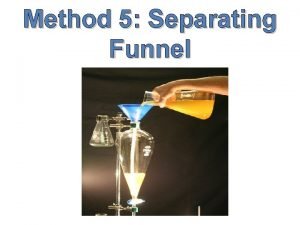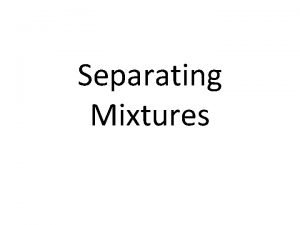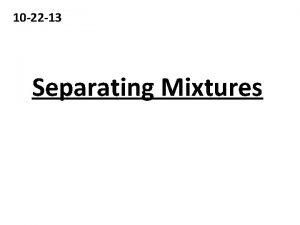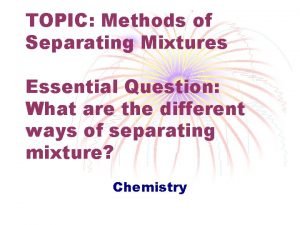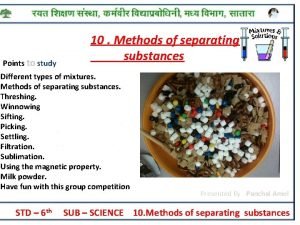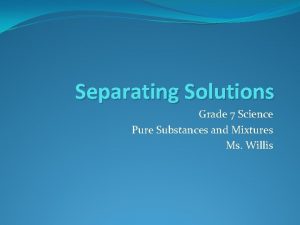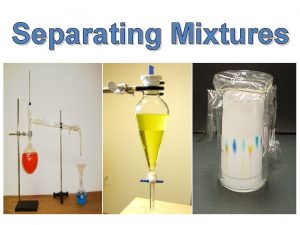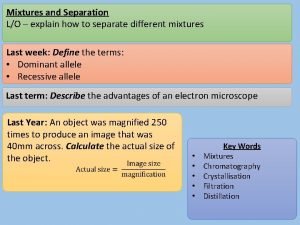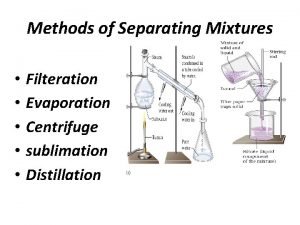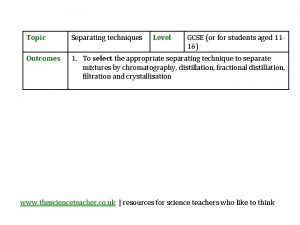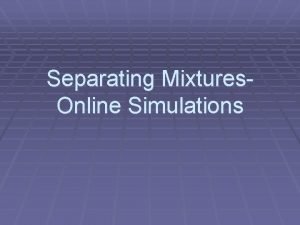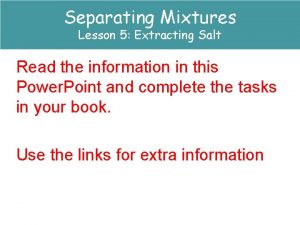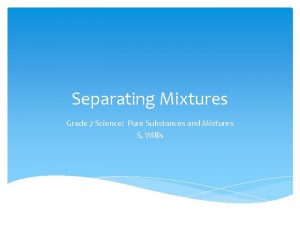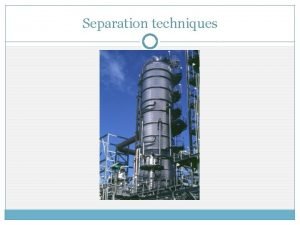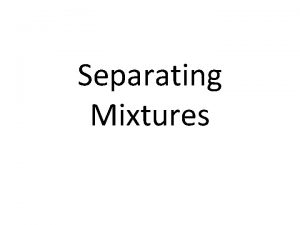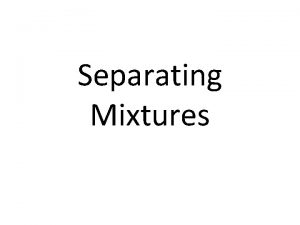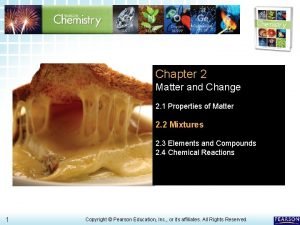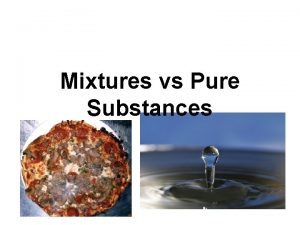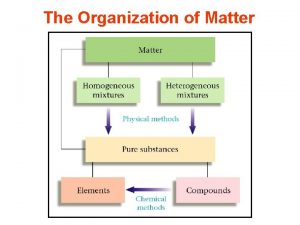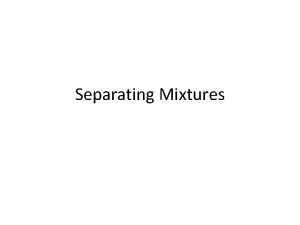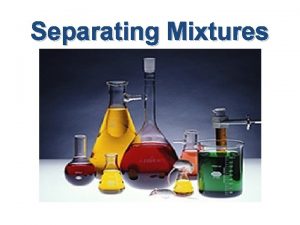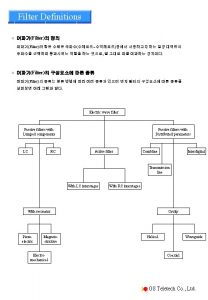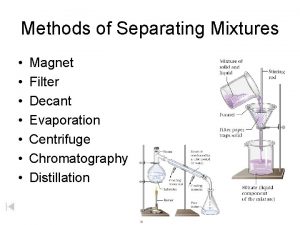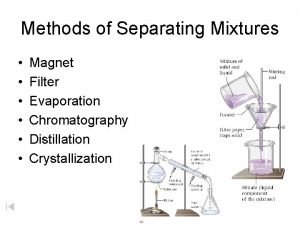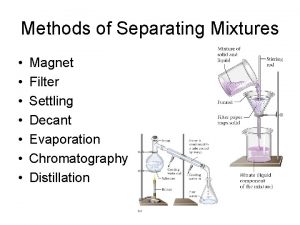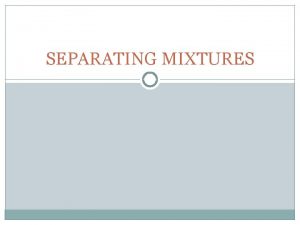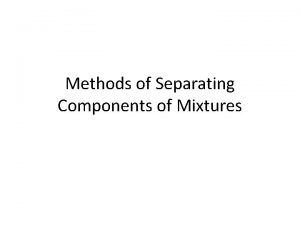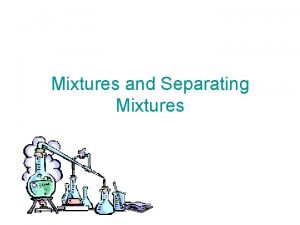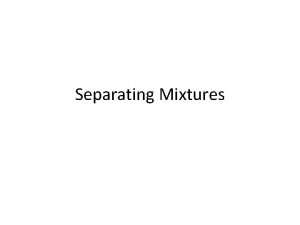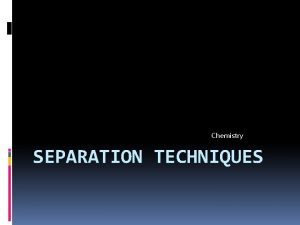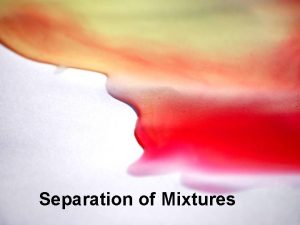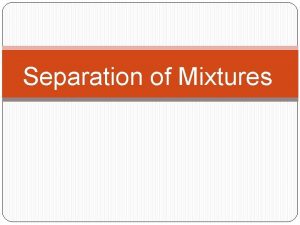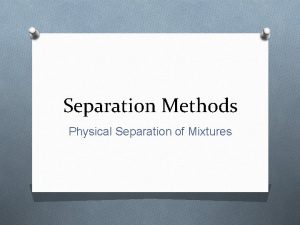Separation Techniques Methods of Separating Mixtures Magnet Filter






















- Slides: 22

Separation Techniques

Methods of Separating Mixtures • • • Magnet Filter Decant Evaporation Distillation

Magnet • Useful for separating a metal from a mixture • Example: extract iron filings from mushed up cereal mixture containing iron

Mixture of solid and liquid Filtration separates a liquid from a solid Zumdahl, De. Coste, World of Chemistry 2002, page 40 Stirring rod Funnel Filter paper traps solid Filtrate (liquid component of the mixture)


Filtration • Separates a liquid from a solid • Use proper size of filter paper for the funnel • Fold filter paper properly • Use distilled water to help keep filter paper open in funnel • Make sure mixture is well stirred • Use glass rod to guide liquid while pouring • Useful for quantitative analysis

Decanting • Also useful for separating a solid from a liquid • Simply pouring the top layer of liquid into another container and leaving the solid behind • To avoid losing any solid some liquid may need to be left behind • Useful when quantitative study is NOT required

Evaporation • Same concept as distillation but simpler set up • Simply use evaporating dish to heat the solution until only the solid remains • Be careful not to over heat and cook the solidd

Setup to heat a solution Ring stand Beaker Wire gauze Ring Bunsen burner Zumdahl, De. Coste, World of Chemistry 2002, page 42

Distillation Copyright © 2007 Pearson Benjamin Cummings. All rights reserved.

A Distillation Apparatus thermometer liquid with a solid dissolved in it condenser tube distilling flask Dorin, Demmin, Gabel, Chemistry The Study of Matter , 3 rd Edition, 1990, page 282 hose connected to cold water faucet receiving flask pure liquid

The solution is boiled and steam is driven off. Zumdahl, De. Coste, World of Chemistry 2002, page 39

Salt remains after all water is boiled off. Zumdahl, De. Coste, World of Chemistry 2002, page 39

No chemical change occurs when salt water is distilled. Distillation (physical method) Saltwater solution (homogeneous mixture) Zumdahl, De. Coste, World of Chemistry 2002, page 40 Pure water

Electrolysis

Water Molecules Zumdahl, De. Coste, World of Chemistry 2002, page 8

The decomposition of two water molecules. Water molecules Diatomic oxygen molecule + Diatomic hydrogen molecules Electric current 2 H 2 O O 2 + 2 H 2

Electrolysis “electro” = electricity “lysis” = to split H 2 O(l) water *H 1+ Water Oxygen gas forms Hydrogen gas forms O 2 (g) + 2 H 2 (g) oxygen *Must add acid catalyst to conduct electricity Zumdahl, De. Coste, World of Chemistry 2002, page 32 hydrogen Source of direct current Electrode

Electrolysis of Water D. C. power source oxygen gas hydrogen gas anode cathode Half reaction at the cathode (reduction): 4 H 2 O + 4 e - 2 H 2 + 4 OH 1 Half reaction at the anode (oxidation): 2 H 2 O O 2 + 4 H 1+ + 4 e - water

Steps to Separate a mixture • Begin with a mixture of sand salt • What are the steps you would follow to separate the sand the salt • You want to end up with pure dry salt and dry sand with no salt left in it

Separation of a sand-saltwater mixture. Zumdahl, De. Coste, World of Chemistry 2002, page 40

Separation of Sand from Salt 1. Gently break up your salt-crusted sand with a plastic spoon. Follow this flowchart to make a complete separation. Saltcrusted sand. Calculate weight of salt. Weigh the mixture. Weigh sand. Pour into heat-resistant container. Fill with water. Stir and let settle 1 minute. Decant clear liquid. Dry sand. No 2. How does this flow chart insure a complete separation? Evaporate to dryness. Yes Repeat 3 times? Wet sand.
 Uses of separating funnel
Uses of separating funnel Methods of separating mixtures magnetism
Methods of separating mixtures magnetism How to seperate salt and sand
How to seperate salt and sand Centrifuge separating mixtures
Centrifuge separating mixtures Separation of camphor and salt by sublimation
Separation of camphor and salt by sublimation Distillation grade 7
Distillation grade 7 5 importance of separating mixtures
5 importance of separating mixtures What is evaporation in mixtures
What is evaporation in mixtures Properties of matter and materials grade 7
Properties of matter and materials grade 7 Chromatography separating mixtures
Chromatography separating mixtures Sublimation separating mixtures
Sublimation separating mixtures Separating mixtures gcse
Separating mixtures gcse Separating mixtures simulation
Separating mixtures simulation Chemistry separating mixtures worksheet
Chemistry separating mixtures worksheet Separating mixtures grade 7
Separating mixtures grade 7 Objectives in separating mixtures
Objectives in separating mixtures Example of magnetism in separating mixtures
Example of magnetism in separating mixtures 14. separating mixtures of liquids.
14. separating mixtures of liquids. Crystallization separating mixtures
Crystallization separating mixtures Evaporation separating mixtures examples
Evaporation separating mixtures examples Separating mixtures
Separating mixtures Pure substance picture
Pure substance picture Solid mixtures
Solid mixtures
